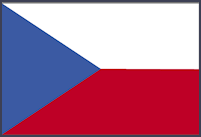Czech Republic - Introduction
 The Czech Republic is a landlocked country, lying in the central part of Europe in the middle of the temperate zone of the northern hemisphere. The country's borders make up neighbourhood with Poland (761.8 km), Germany (810.3 km), Austria (466.3 km) and Slovakia (251.8 km). The major European watershed passes through the teritory of the Czech Republic to separate the basins of the North, Baltic and Black Seas. Principal rivers are the Labe (370 km) and the Vltava (433 km) in Bohemia, the Morava (246 km) and the Dyje (306 km) in Moravia, and the Odra (135 km) and the Opava (131 km) in Silesia and northern Moravia.
The Czech Republic is a landlocked country, lying in the central part of Europe in the middle of the temperate zone of the northern hemisphere. The country's borders make up neighbourhood with Poland (761.8 km), Germany (810.3 km), Austria (466.3 km) and Slovakia (251.8 km). The major European watershed passes through the teritory of the Czech Republic to separate the basins of the North, Baltic and Black Seas. Principal rivers are the Labe (370 km) and the Vltava (433 km) in Bohemia, the Morava (246 km) and the Dyje (306 km) in Moravia, and the Odra (135 km) and the Opava (131 km) in Silesia and northern Moravia.
The Czech Republic can be found on the borderline of two mountain systems. The western and central parts of the country are occupied by the hilly uplands Ceská vysocina and by the low mountain ranges Sumava, Ceský les, Krusné hory, Krkonose, Orlické hory, and Jeseníky . The Západní Karpaty Mountains (Beskydy) penetrate into the eastern part of the country.
The climate of the Czech Republic is affected by the interaction of oceanic and continental effects. Western winds prevail and intensive cyclone type activities frequently change air masses and bring rather heavy precipitation. The maritime effect is mainly felt in Bohemia, continental climate effects have a bigger impact on Moravia and Silesia. Altitude and relief influence the climate to a large extent. 52 817 km2 of the country's whole territory (66.97%) can be found at an altitude below 500 m, 25 222 km2 (31.68%) between 500 to 1 000 m, and only 827 km2 above 1 000 m. The average altitude of the Czech Republic is 430 m.
The fauna and flora found in the country also testify to the mutual penetration of principal directions in which fauna and flora have propagated in Europe. Forests, mostly coniferous, cover 33% of the total area. The soil cover is also varied. Brown soils are the most prevalent soil type in the Czech Republic.
Until February 1948, Czechoslovakia had been a pluralistic, democratic state, mindful of Soviet national security concerns but linked economically and intellectually to the West. Then, in the space of seven days, it was abruptly transformed into a Communist dictatorship, a shattering development because it suggested a replay of events that had led to the last world war.
The present-day Czech Republic, as one of the two succession states of the Czech and Slovak Federative Republic, emerged on 1 January 1993 (the other newly established country being the Slovak Republic). Historically it resumes the tradition of the Czechoslovak Republic. It consists of the historical lands of Bohemia, Moravia and the south-eastern part of Silesia. The peaceful division of the Czech and Slovak Federative Republic and the fact that friendly relations have been preserved between populations of both succession states went down in European history, particularly in the context of disintegration of the former Yugoslavia and the follow-up events in the Balkans, as an important example of a civilised resolution of a nationality dispute. The Czech Republic is an independent, united state based on the principles of democracy and the rule of law. Its capital is Prague (other major towns are Brno, Ostrava, Plzen, Liberec, Hradec Králové, Ceské Budejovice, Pardubice etc.)
Thanks to its position in the heart of Europe the country has been confronted with various cultural influences and architectural styles in the course of its history. Since the country suffered little damage during the World War II, nor destruction due to redevelopment projects, a rich cultural heritage has been preserved. In the Czech Republic there are a total of 12 listed heritage reservations recognized by the international organization UNESCO: Prague - the historic centre, Cesky Krumlov - the historic centre, Telc - the historic centre, Zdar nad Sazavou - the pilgrimage church of St. Jan Nepomucky on Zelena Hora, Kutna Hora - the historic centre, Lednice - the Lednicko-Valticky grounds, Holasovice - the village reservation, Kromeriz - the gardens and palace, Litomysl - the palace and its grounds, Olomouc - the column of the Holy Trinity, Brno - Villa Tugendhat, Trebic - the Jewish quarter and St. Procopus Basilica.
|
NEWSLETTER
|
| Join the GlobalSecurity.org mailing list |
|
|
|

